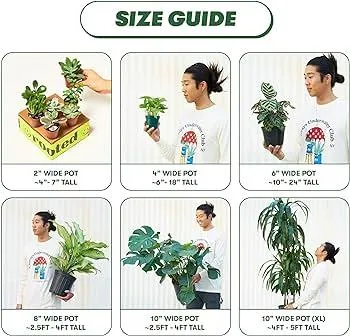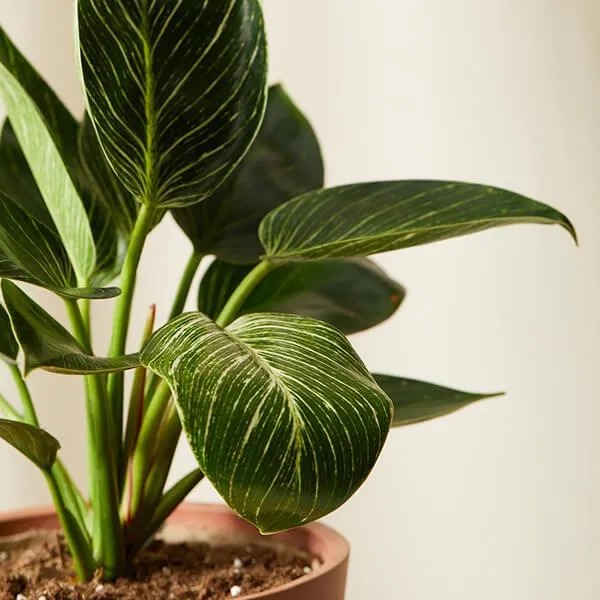
Care Guide for Philodendron Velvet Leaf – A Beginner’s Guide to Growing Velvet Leaf Philodendron Plants Indoors
Everything You Need to Know About the Philodendron Velvet Leaf Plant
The philodendron velvet leaf is a beautiful indoor foliage plant with intriguing velvety leaves. If you’ve searched for info on this plant, you’ve probably got a bunch of questions – so let me try and cover all the basics for you in this one mega-guide!
What Is a Philodendron Velvet Leaf?
Simply put, the philodendron velvet leaf (Philodendron erubescens) is a type of tropical philodendron characterized by its soft, fuzzy leaves. As the name implies, the leaves have a velvety texture that’s kinda like velour – very smooth and plush to the touch. It’s native to tropical regions in South America.
Appearance and Growth Habits
- Leaves: As mentioned, the leaves are roundish-ovate in shape with a deep green color on top and a reddish-purple hue underneath. They can grow up to 10 inches long.
- Stems: The stems are woody and trailing, allowing the plant to climb or cascade over the edges of pots and shelves.
- Flowers: Small white flowers may occasionally appear, though the plant is usually grown for its beautiful foliage.
- Growth: It’s a moderately fast grower for an indoor plant. Expect new leaves to unfurl every couple months or so.
From my experience keeping one as a houseplant, it’s a pretty dramatic looking foliage plant once it gets going. The velvety texture really stands out.
Care Requirements
The good news is philodendron velvet leaf is fairly low maintenance as houseplants go. But here are the basics:
Light: They thrive in bright, indirect sunlight but can tolerate low indoor light pretty well. Direct sun may scorch the leaves.
Soil: Use a well-draining potting mix. I like adding perlite or orchid bark to the regular potting soil to improve drainage.
Water: Allow the top inch of soil to dry out between waterings. They can tolerate drying out more than most other philodendrons.
Humidity: Higher humidity around 50% or more will promote healthy growth. You can use a pebble tray or humidifier.
Fertilizer: Feed monthly in the growing season with a diluted liquid houseplant fertilizer.

Temperature: It prefers warmer conditions above 60°F. Watch it doesn’t get chilled in drafty rooms near windows.
Cool, eh? Once you get the hang of it, the velvet leaf is pretty low fuss. Though I have forgetten to water mine a few times, oops!
Pests and Diseases
Most philodendron varieties are relatively pest-free. However, you may occasionally spot:
- Spider mites: Tiny spider-like critters that suck plant juices. Wipe leaves with a damp cloth or neem oil spray.
- Scale: Small, hard-shell insects that cling to leaves. Scrape off with your fingernail or treat with horticultural oil.
- Mealybugs: Fluffy white bugs that secrete sticky “honeydew.” Wipe with alcohol or treat with insecticide.
Diseases are less common with good care. Watch for leaf spotting or yellowing, which could signal issues like overwatering. Cut off badly infected areas and improve conditions. Fingers crossed you don’t have any pest or disease dramas!
Propagation
If your velvet leaf is looking lush, you may want to make more plants! Propagation is easy using stem or leaf cuttings. Simply remove 4-6 inch sections, let the cut end dry and callus for a few days, then stick them into moist potting mix. Mist the area and keep humidity high. Roots should form within a few weeks. Boom, you’ve got baby philodendrons!
Plant Placement at Home
Philodendrons are super flexible plants that adapt to different conditions. Here are some placement options:
– On a bathroom window shelf for the humidity. Great for showing off the leaves.
– Hanging planters work well to trail the stems. Mount them on walls or above cabinets.
– Group a few together on a kitchen windowsill or in your dining room. Their feathery foliage adds lush texture.

– Try an uncommon spot like hanging in your shower (eau natural mister included ha).
– Use a tabletop planter on your desk at work to brighten your day.
Basically anywhere you want a low maintenance tropical accent plant. The velvet leaf fits the bill perfectly.
Tips and Tricks
Here are a few extras that may help your plant thrive:
– Rotate pots occasionally so leaves grow evenly. They lean towards the light source.
– Wipe leaves with a damp cloth weekly to remove dust and promote a shiny appearance.
– Repot only when roots start to emerge from the drainage holes, using a pot just 1-2 inches larger.
– Give it a “ponytail” style climbing pole or moss pole for trailing stems to climb. Adds a unique look.
– Consider propagating cuttings as gifts – the velvety texture and heart shape are so appealing!

– Place a ziplock baggie over new growth if bringing indoors, to keep humidity high as it acclimates.
Well folks, I hope this mega-guide has covered pretty much everything you’d want to know about keeping a philodendron velvet leaf plant! Let me know if any other questions come to mind. Happy planting!
Philodendron Velvet Leaf Care Tips
| Light | Bright, indirect light. Avoid direct sunlight which can burn leaves. |
|---|---|
| Water | Water when top inch of soil is dry. Allow soil to dry between waterings. Do not overwater. |
| Humidity | Prefers medium to high humidity. Mist leaves frequently or group with other plants. |
| Temperature | Keep above 60°F. Tolerates temperatures between 65-80°F. |
| Soil | Well-draining potting soil. Do not allow soil to stay soggy. |
| Fertilizer | Feed monthly in growing season with dilute fertilizer. Reduce in winter. |
FAQ
-
What is a philodendron velvet leaf?
The philodendron velvet leaf is a type of houseplant. It’s known for its dark green leaves that feel super soft and fuzzy, almost like velvet. Pretty neat, right?
-
What care does it need?
This plant is pretty low maintenance. It likes indirect sunlight and only needs water when the top inch of soil is dry. You’ll want to mist the leaves every so often to keep them looking their fuzziest. Fertilize in the growing season for happiest leaves.
-
How fast does it grow?
The velvet leaf philodendron can grow pretty quick during the spring and summer. You may see a new leaf unfurling every couple weeks or so. However, its growth might slow way down in the winter when light levels are lower. So don’t worry if it seems to hit snooze for a bit during the colder months.
-
Can it trail or climb?
You bet! If given something to climb, this philodendron will send out aerial roots to hoist itself up. You can train it up a moss pole or let it cascade over the edge of a hanging basket. It provides that sweet trailing or climbing texture. Pretty rad for an indoor plant, if I do say so myself.
-
Is it toxic to pets?
Sadly, many plants can be harmful if ingested by cats or dogs. The ASPCA lists philodendron as “moderately toxic” to pets. While a single leaf probably won’t hurt Fido, it’s best to keep curious paws away as a precaution. Maybe put tall plant up high where pets can’t reach.
-
Any pests to watch out for?
For the most part, philodendron is pretty pest-free. But spider mites can sometimes be a bother. Look out for tiny spider-like bugs and webbing on the undersides of leaves. Wipe down with water or neem oil if you spot infestation. Other than that, it’s a pretty tough plant!

On the other hand, while velvet leaf philodendron is generally easygoing, its care requirements may differ from what you’re used to with other plants. Check with houseplant experts if you find it’s not thriving as you’d expect. At the same time, have patience – even experienced green thumbs can hit a few bumps along the way. The good news is philodendrons are very resilient. With some TLC, I’m sure your new leafy friend will be looking fabulous in no time. Let me know if you have any other questions!